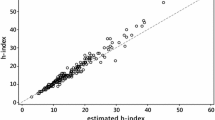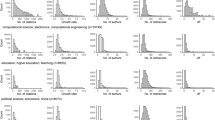Abstract
Internet has made it possible to move towards researcher and article impact instead of solely focusing on journal impact. To support citation measurement, several indexes have been proposed, including the h-index. The h-index provides a point estimate. To address this, a new index is proposed that takes the citation curve of a researcher into account. This article introduces the index, illustrates its use and compares it to rankings based on the h-index as well as rankings based on publications. It is concluded that the new index provides an added value, since it balances citations and publications through the citation curve.
Similar content being viewed by others
References
Batista, P. D., Campiteli, M. G., Kinouchi, O., Martinez, A. S. (2006), Is it possible to compare researchers with different scientific interests? Scientometrics, 68(1): 179–189.
Egghe, L. (2006), Theory and practice of the g-index, Scientometrics, 69(1): 131–152.
Garfield, E., Sher, I. H. (1963), New Factors in the evaluation of scientific literature through citation indexing, American Documentation, 14(3): 195–201.
Garfield, E. (2006), The history and meaning of the journal impact factor, Journal of the American Medical Association, 295(1): 90–93.
Glänzel, W. (2007), Characteristic scores and scales: A bibliometric analysis of subject characteristics based on long-term citation observation, Journal of Informetrics, 1: 92–102.
Google Scholar (2008), http://scholar.google.com (accessed October 31, 2008).
Hirsch, J. E. (2005), An index to quantify an individual’s scientific research output, Proceedings of the National Academy of Science of the United States, 102(46): 16569–16572.
Thompson (2008), http://isi3.isiknowledge.com (accessed October 31, 2008).
Journal of Systems and Software (2008), http://www.elsevier.com/locate/jss (accessed October 31, 2008)
Publish or Perish (2008), http://www.harzing.com (accessed October 31, 2008).
Ren, J., Taylor, R. N. (2007), Automatic and versatile publications ranking for research institutions and scholars, Communications of the ACM, 50(6): 81–85.
Scopus (2008), http://www.scopus.com (accessed October 31, 2008).
Sidiropouos, A., Katsaros, D., Manolopolos, Y. (2006), Generalized h-index for disclosing latent facts in citation networks, arXiv:cs.DL/0607066. Available: http://arxiv.org/abs/cs.DL/0607066 (accessed October 31, 2008).
Tse, T. H., Chen, T. Y., Glass, R. L. (2006), An assessment of systems and software engineering scholars and institutions (2000–2004), Journal of Systems and Software, 79(6): 816–819.
Wohlin, C. (2008), An analysis of the most cited articles in software engineering journals — 2001, Information and Software Technology, 50(1–2): 3–9.
Author information
Authors and Affiliations
Corresponding author
Rights and permissions
About this article
Cite this article
Wohlin, C. A new index for the citation curve of researchers. Scientometrics 81, 521–533 (2009). https://doi.org/10.1007/s11192-008-2155-z
Received:
Published:
Issue Date:
DOI: https://doi.org/10.1007/s11192-008-2155-z




